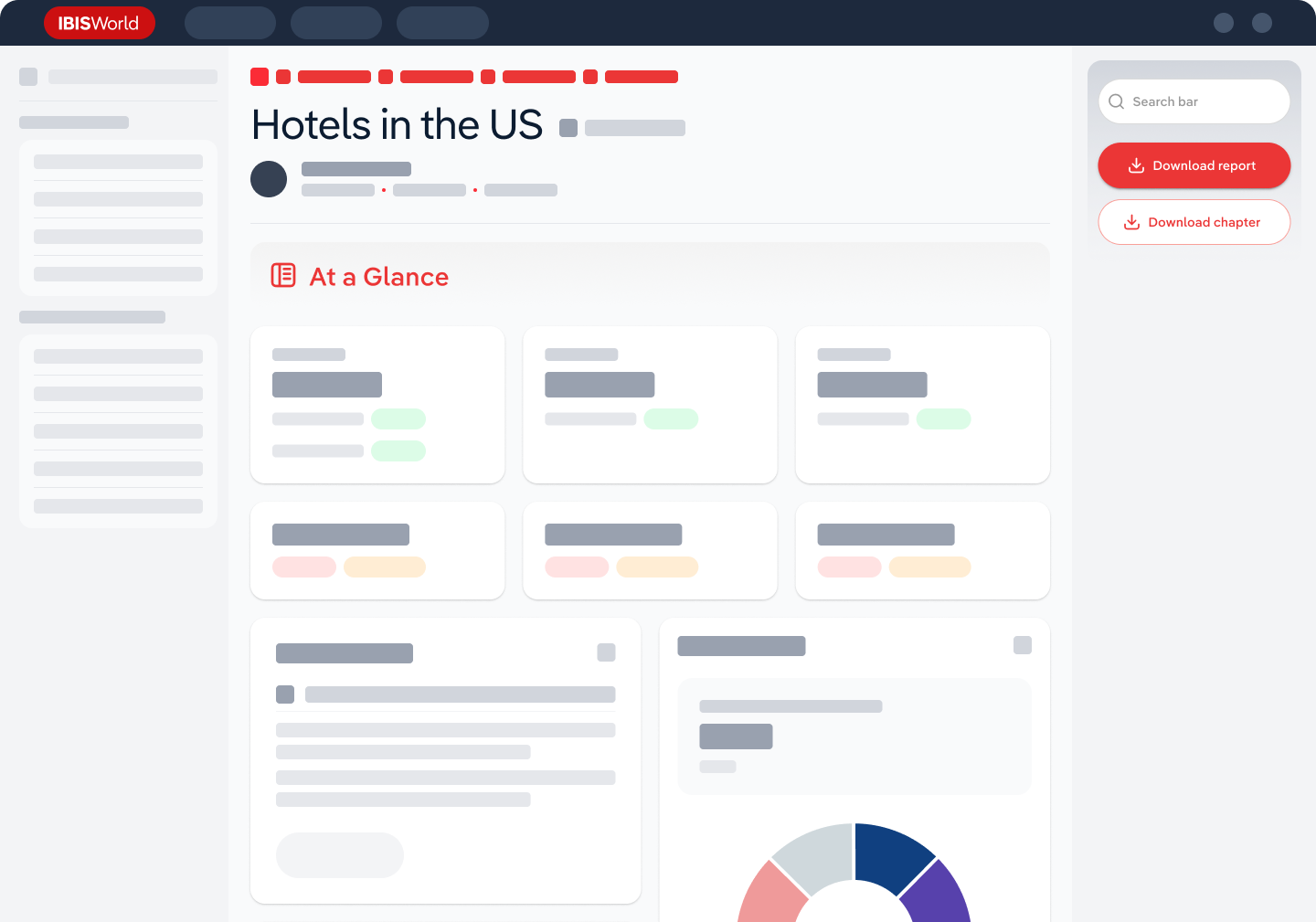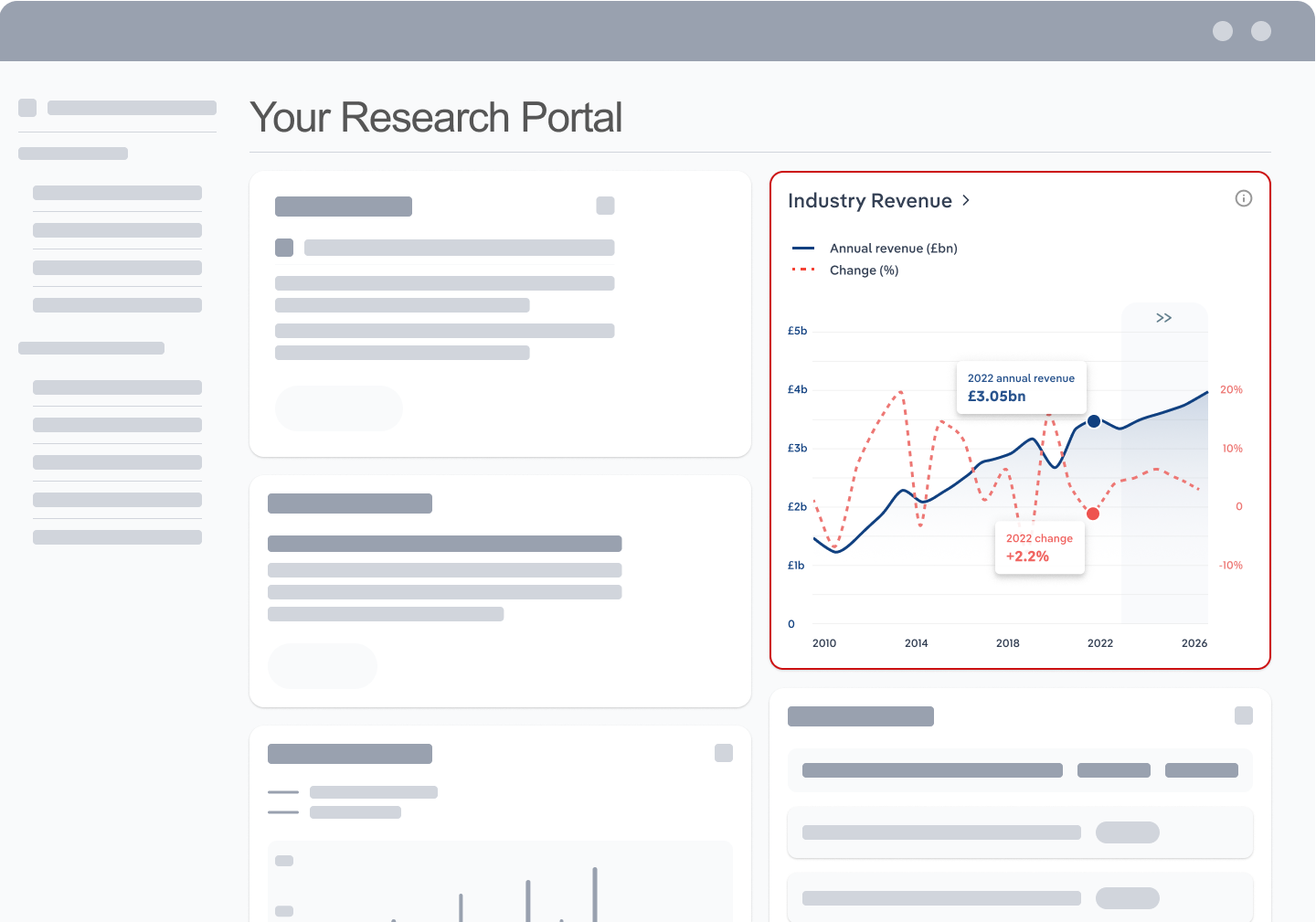Industry Statistics and Trends
Market size and recent performance (2015-2030)
Industry revenue has grown at a CAGR of 0.9 % over the past five years, to reach an estimated $243.1bn in 2025.
Trends and Insights
Data centers as a REIT asset class
- Data center REITs have emerged as a transformative force in the industry, driven by the rapid growth of artificial intelligence (AI), cloud computing and digital transformation. This remarkable growth reflects their critical role in supporting the digital economy through long-term leases and stable cash flows.
- Additional trends and insights available with purchase
Industry outlook (2025-2030)
Market size is projected to grow over the next five years.
Trends and Insights
Moderating interest rates will benefit the industry
- The interest rate environment is evolving, with rates expected to moderate over the next five years following the Federal Reserve’s aggressive tightening cycle. While long-term rates may remain higher than pre-pandemic levels, a stabilization or gradual drop will ease borrowing costs for REITs, which rely heavily on debt financing for acquisitions and development. However, elevated rates could still challenge REITs that operate in sectors with thinner profit or those with significant refinancing needs.
Biggest companies in the Real Estate Investment Trusts in the US
| Company | Market Share (%)
2025 | Revenue
2025 | Profit
2025 | Profit Margin (%)
2025 |
|---|
There are no companies that hold a market share exceeding 5% in the Real Estate Investment Trusts in the US industry.
Products & Services Segmentation
Industry revenue is measured across several distinct product and services lines, including Residential equity REITs , Retail equity REITs and Other commercial equity REITs . Residential equity REITs is the largest segment of the Real Estate Investment Trusts in the US.
Trends and Insights
Other commercial equity REITs power the industry's growth
- Other commercial equity REITs include those focused on telecommunications, office, healthcare, industrial and data center sectors. Telecommunications REITs specialize in owning and operating communication infrastructure such as cell towers, broadcast towers and other wireless communication sites. These REITs lease space on their towers to wireless carriers, broadcasting companies and other telecommunications service providers. Office REITs own, manage and lease office buildings to tenants such as corporations, government agencies, technology firms and financial institutions. These properties range from skyscrapers in central business districts to suburban office parks.
- More insights available in the full report
Table of Contents
About this industry
Industry definition
This industry comprises legal entities that are categorized as real estate investment trusts (REITs). REITs, such as mutual funds, use the pooled capital of many investors to directly invest in income-yielding properties. To qualify as a REIT, a company or trust must distribute at least 90.0% of their taxable income to shareholders annually. Income is largely generated from rent, interest and capital gains.
What's included in this industry?
Products and services covered in the Real Estate Investment Trusts industry in the United States include Residential equity REITs , Retail equity REITs , Other commercial equity REITs , Other REITs, Hybrid REITs and Mortgage REITs.Companies
Companies covered in the Real Estate Investment Trusts industry in the United States include .Purchase this report to view all major companies in this industry.
Related Terms
Related terms covered in the Real Estate Investment Trusts industry in the United States include equity reit, mortgage reit, hybrid reit, leadership in energy and environmental design, mezzanine loans, funds from operations (ffo), loan-to-value ratio (ltv), mortgage-backed securities (mbss), real estate investment trust (reit) and debt-to-ebitda.Industry Code
NAICS 525990 - Real Estate Investment Trusts in the US
Performance
Get an indication of the industry's health through historical, current and forward-looking trends in the performance indicators that make or break businesses.
Analyst insights
Data centers have emerged as a significant REIT asset class, driven by a digital shift, AI advancements and the need for hyperscale facilities. With tech giants investing in ...
In this chapter (4)
- Current Performance
- Outlook
- Volatility
- Life Cycle
Key metrics
- Annual Revenue, Recent Growth, Forecast, Revenue Volatility
- Number of Employees, Recent Growth, Forecast, Employees per Business, Revenue per Employee
- Number of Businesses, Recent Growth, Forecast, Employees per Business, Revenue per Business
- Total Profit, Profit Margin, Profit per Business
Charts
- Revenue, including historical (2015-2024) and forecast (2025-2030)
- Employees, including historical (2015-2024) and forecast (2025-2030)
- Businesses, including historical (2015-2024) and forecast (2025-2030)
- Profit, including historical (2015-2025)
- Industry Volatility vs. Revenue Growth
- Industry Life Cycle
Detailed analysis
- Trends in supply, demand and current events that are driving current industry performance
- Expected trends, economic factors and ongoing events that drive the industry's outlook
- Key success factors for businesses to overcome volatility
- How contribution to GDP, industry saturation, innovation, consolidation, and technology and systems influence the industry's life cycle phase.
Products and Markets
Learn about an industry's products and services, markets and trends in international trade.
Analyst insight
Residential REITs are experiencing growth because of population gain, urbanization and changing housing preferences. The tight housing market particularly favors this sector,...
In this chapter
- Products & Services
- Major Markets
Key metrics
- Largest market segment and value in 2025
- Product innovation level
Charts
- Products & services segmentation in 2025
- Major market segmentation in 2025
Detailed analysis
- Trends impacting the recent performance of the industry's various segments
- Innovations in the industry's product or service offering, specialization or delivery method
- Key factors that successful businesses consider in their offerings
- Buying segments and key trends influencing demand for industry products and services
Geographic Breakdown
Discover where business activity is most concentrated in an industry and the factors driving these trends to find opportunities and conduct regional benchmarking.
Analyst insights
REITs favor California because of its high-income markets and location advantages. Being close to key industry clusters improves access to tenants, international capital and ...
In this chapter (1)
- Business Locations
Charts
- Share of revenue, establishment, wages and employment in each state
- Share of population compared to establishments in each region in 2025
Tables
- Number and share of establishments in each state in 2025
- Number and share of revenue each state accounts for in 2025
- Number and share of wages each state accounts for in 2025
- Number and share of employees in each state in 2025
Detailed analysis
- Geographic spread of the industry across North America, and trends associated with changes in the business landscape
- Key success factors for businesses to use location to their advantage
Competitive Forces
Get data and insights on what's driving competition in an industry and the challenges industry operators and new entrants may face, with analysis built around Porter's Five Forces framework.
Analyst insights
Investor sentiment can significantly impact a REIT's ability to raise capital. Positive sentiment often drives up REIT stock prices, easing capital raising, while negative se...
In this chapter (4)
- Concentration
- Barriers to Entry
- Substitutes
- Buyer & Supplier Analysis
Key metrics
- Industry concentration level
- Industry competition level and trend
- Barriers to entry level and trend
- Substitutes level and trend
- Buyer power level and trend
- Supplier power level and trend
Charts
- Market share concentration among the top 4 suppliers from 2020-2025
- Supply chain including upstream supplying industries and downstream buying industries, flow chart
Detailed analysis
- Factors impacting the industry’s level of concentration, such as business distribution, new entrants, or merger and acquisition activity.
- Key success factors for businesses to manage the competitive environment of the industry.
- Challenges that potential industry entrants face such as legal, start-up costs, differentiation, labor/capital intensity and capital expenses.
- Key success factors for potential entrants to overcome barriers to entry.
- Competitive threats from potential substitutes for the industry’s own products and services.
- Key success factors for how successful businesses can compete with substitutes.
- Advantages that buyers have to keep favorable purchasing conditions.
- Advantages that suppliers have to maintain favorable selling conditions.
- Key success factors for how businesses can navigate buyer and supplier power.
Companies
There are no companies that hold a market share exceeding 5% in the Real Estate Investment Trusts in the US industry.
Analyst insights
REITs offer exposure to various property sectors, including retail, healthcare and data centers, mitigating risks associated with specific industries. This diversity helps co...
External Environment
Understand the demographic, economic and regulatory factors that shape how businesses in an industry perform.
Analyst insights
The yield on the 10-year Treasury note has a considerable impact on REITs' financing costs and profit. When the yield decreases, borrowing becomes cheaper for REITs, increasi...
In this chapter
- External Drivers
- Regulation & Policy
- Assistance
Key metrics
- Regulation & policy level and trend
- Assistance level and trend
Charts
- Regulation & Policy historical data and forecast (2015-2030)
- Assistance historical data and forecast (2015-2030)
Detailed analysis
- Demographic and macroeconomic factors influencing the industry, including Regulation & Policy and Assistance
- Major types of regulations, regulatory bodies, industry standards or specific regulations impacting requirements for industry operators
- Key governmental and non-governmental groups or policies that may provide some relief for industry operators.
Financial Benchmarks
View average costs for industry operators and compare financial data against an industry's financial benchmarks over time.
Analyst insights
The shifting operating environment and higher interest rates have pressured the profit of the REIT industry. Cyclical headwinds and structural shifts, such as remote work and...
In this chapter
- Cost Structure
- Financial Ratios
- Key Ratios
Key metrics
- Profit margin, and how it compares to the sector-wide margin
- Average wages, and how it compares to the sector-wide average wage
- Largest cost component as a percentage of revenue
- Industry average ratios for days' receivables, industry coverage and debt-to-net-worth ratio
Charts
- Average industry operating costs as a share of revenue, including purchases, wages, depreciation, utilities, rent, other costs and profit in 2025
- Average sector operating costs as a share of revenue, including purchases, wages, depreciation, utilities, rent, other costs and profit in 2025
- Investment vs. share of economy
Data tables
- Industry Multiples (2018-2023)
- Industry Tax Structure (2018-2023)
- Income Statement (2018-2023)
- Balance Sheet (2018-2023)
- Liquidity Ratios (2018-2023)
- Coverage Ratios (2018-2023)
- Leverage Ratios (2018-2023)
- Operating Ratios (2018-2023)
- Cash Flow & Debt Service Ratios (2015-2030)
- Revenue per Employee (2015-2030)
- Revenue per Enterprise (2015-2030)
- Employees per Establishment (2015-2030)
- Employees per Enterprise (2015-2030)
- Average Wage (2015-2030)
- Wages/Revenue (2015-2030)
- Establishments per Enterprise (2015-2030)
- IVA/Revenue (2015-2030)
- Imports/Demand (2015-2030)
- Exports/Revenue (2015-2030)
Detailed analysis
- Trends in the cost component for industry operators and their impact on industry costs and profitability
Key Statistics
Industry Data
Data Tables
Including values and annual change:
- Revenue (2015-2030)
- IVA (2015-2030)
- Establishments (2015-2030)
- Enterprises (2015-2030)
- Employment (2015-2030)
- Exports (2015-2030)
- Imports (2015-2030)
- Wages (2015-2030)
Top Questions Answered
Unlock comprehensive answers and precise data upon purchase. View purchase options.
What is the market size of the Real Estate Investment Trusts industry in the United States in 2025?
The market size of the Real Estate Investment Trusts industry in the United States is $243.1bn in 2025.
How many businesses are there in the Real Estate Investment Trusts industry in the United States in 2025?
There are 2,140 businesses in the Real Estate Investment Trusts industry in the United States, which has declined at a CAGR of 2.5 % between 2020 and 2025.
How may import tariffs affect the Real Estate Investment Trusts industry in the United States?
The Real Estate Investment Trusts industry in the United States is unlikely to be materially impacted by import tariffs with imports accounting for a low share of industry revenue.
How may export tariffs affect the Real Estate Investment Trusts industry in the United States?
The Real Estate Investment Trusts industry in the United States is unlikely to be materially impacted by export tariffs with exports accounting for a low share of industry revenue.
Has the Real Estate Investment Trusts industry in the United States grown or declined over the past 5 years?
The market size of the Real Estate Investment Trusts industry in the United States has been growing at a CAGR of 0.9 % between 2020 and 2025.
What is the forecast growth of the Real Estate Investment Trusts industry in the United States over the next 5 years?
Over the next five years, the Real Estate Investment Trusts industry in the United States is expected to grow.
What does the Real Estate Investment Trusts industry in the United States include?
Residential equity REITs and Retail equity REITs are part of the Real Estate Investment Trusts industry in the United States.
How competitive is the Real Estate Investment Trusts industry in the United States?
The level of competition is moderate and increasing in the Real Estate Investment Trusts industry in the United States.
Methodology
How are IBISWorld reports created?
IBISWorld has been a leading provider of trusted industry research for over 50 years to the most successful companies worldwide. With offices in Australia, the United States, the United Kingdom, Germany and China, we are proud to have local teams of analysts that conduct research, data analysis and forecasting to produce data-driven industry reports.
Our analysts start with official, verified and publicly available sources of data to build the most accurate picture of each industry. Analysts then leverage their expertise and knowledge of the local markets to synthesize trends into digestible content for IBISWorld readers. Finally, each report is reviewed by one of IBISWorld’s editors, who provide quality assurance to ensure accuracy and readability.
IBISWorld relies on human-verified data and human-written analysis to compile each standard industry report. We do not use generative AI tools to write insights, although members can choose to leverage AI-based tools within the platform to generate additional analysis formats.
What data sources do IBISWorld analysts use?
Each industry report incorporates data and research from government databases, industry-specific sources, industry contacts, and our own proprietary database of statistics and analysis to provide balanced, independent and accurate insights.
Key data sources in the US include:
- US Census Bureau
- US Bureau of Labor Statistics
- US International Trade Commission
Analysts also use industry specific sources to complement catch-all sources, although their perspective may focus on a particular organization or representative body, rather than a clear overview of all industry operations. However, when balanced against other perspectives, industry-specific sources provide insights into industry trends.
These sources include:
- Industry and trade associations
- Industry federations or regulators
- Major industry players annual or quarterly filings
Finally, IBISWorld’s global data scientists maintain a proprietary database of macroeconomic and demand drivers, which our analysts use to help inform industry data and trends. They also maintain a database of statistics and analysis on thousands of industries, which has been built over our more than 50-year history and offers comprehensive insights into long-term trends.
How does IBISWorld forecast its data?
IBISWorld’s analysts and data scientists use the sources above to create forecasts for our proprietary datasets and industry statistics. Depending on the dataset, they may use regression analysis, multivariate analysis, time-series analysis or exponential smoothing techniques to project future data for the industry or driver. Additionally, analysts will leverage their local knowledge of industry operating and regulatory conditions to impart their best judgment on the forecast model.
IBISWorld prides itself on being a trusted, independent source of data, with over 50 years of experience building and maintaining rich datasets and forecasting tools. We are proud to be the keystone source of industry information for thousands of companies across the world.
Learn more about our methodology and data sourcing on the Help Center.










